The Best Luxury Tour of Myanmar
- 9 Days
Day 1: Arrive in Yangon, Myanmar. Your arrival and departure transfers can be reserved with your guest relations manager, who is assigned to you after you book your tour. We strongly recommend that our guests consider arriving a day earlier, as this allows you to recuperate from jetlag, and serves as insurance against international flight delays and cancellations.
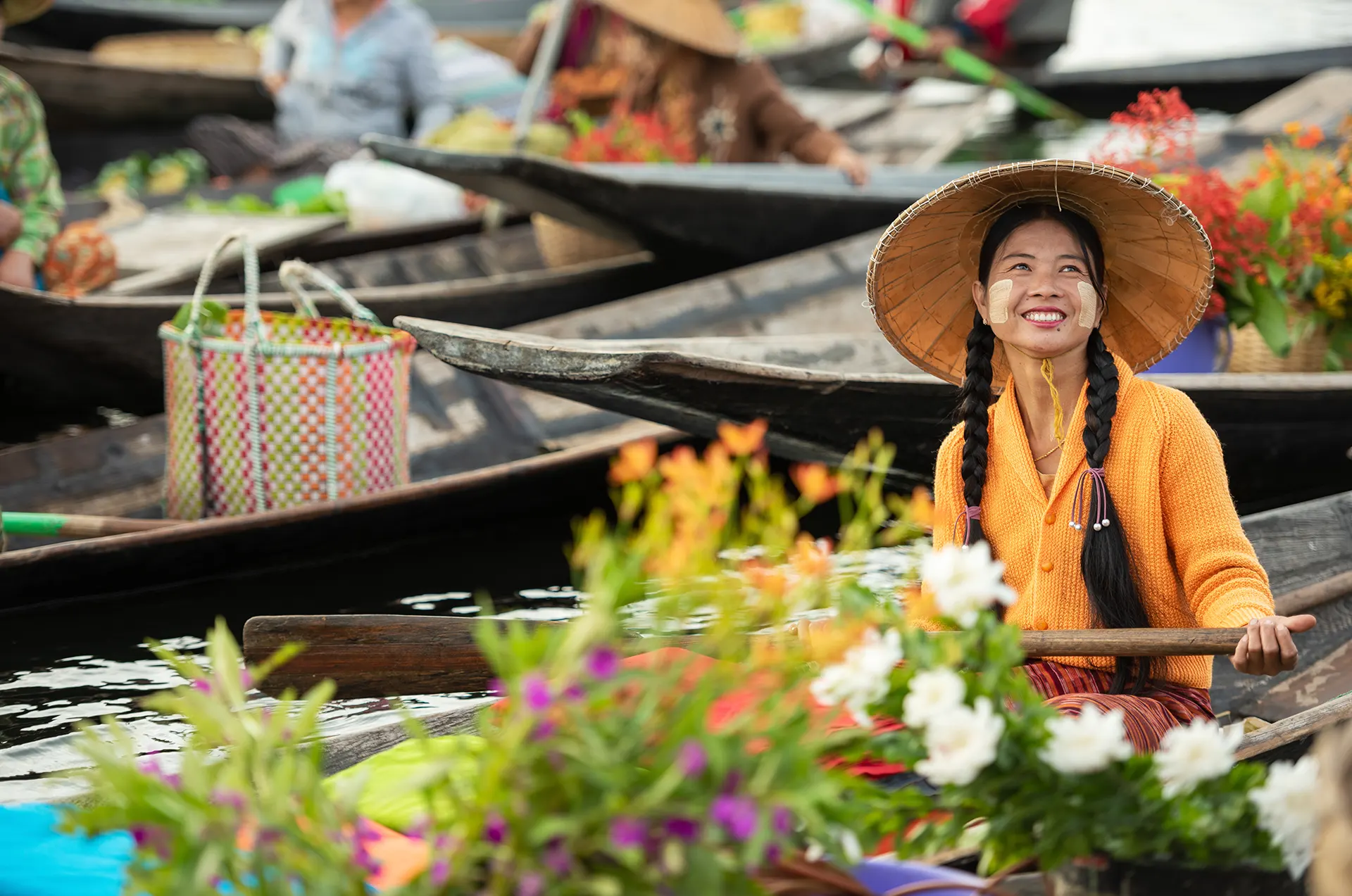
Lady with Thanaka on her Cheeks
An additional night’s lodging at the luxury and historic Rosewood Yangon, the city’s best hotel, can be added as part of the process as you reserve your tour.
If you are arriving a day earlier, your airport to hotel transfer will be provided a day earlier. Our services begin with your luxury VIP greeting as you disembark at Yangon airport. You are greeted as soon as you exit your plane and you will now be escorted through the complete arrival process, including immigration, baggage claim, and customs, and then you will be met by your Travel Facilitator or your Accompanying Myanmar Tour Director. You are then driven to your impeccably restored historic riverfront hotel where you will check-in if it is after 3pm. If your arrival is before 3pm, you can drop your bags off and use the facilities to freshen up, unless you have requested an additional day’s stay.
Welcome to Myanmar, an ancient land with a unique culture, although things are changing fast as the country rapidly grows and evolves, now that the international trade and travel restrictions have been lifted. In the last decade we have seen an incredible amount of development occur in Myanmar, yet the nation still retains a lot of its original charm. It is home to some of the warmest people in the world, and their colorful attire and culture are fascinating to experience.
Myanmar’s biggest city, Yangon (Rangoon), is very different from most of the rest of the country, as it has rapidly progressed and expanded over the last few years. Much of what you will witness is typical of a big Southeast Asian city, with scores of tall commercial and residential buildings, traffic jams, and luxury stores. The wealthier locals lead modern and cosmopolitan, lives, yet everything is still indelibly mixed with their ancient culture and traditions.
Day 2: Yangon. (Breakfast) Begin your exploration of the Yangon region in the historic downtown area of Yangon, where you will enjoy an easy walking tour in the heart of the capital city. You will learn about the history of Yangon and the numerous colonial buildings that you are passing.
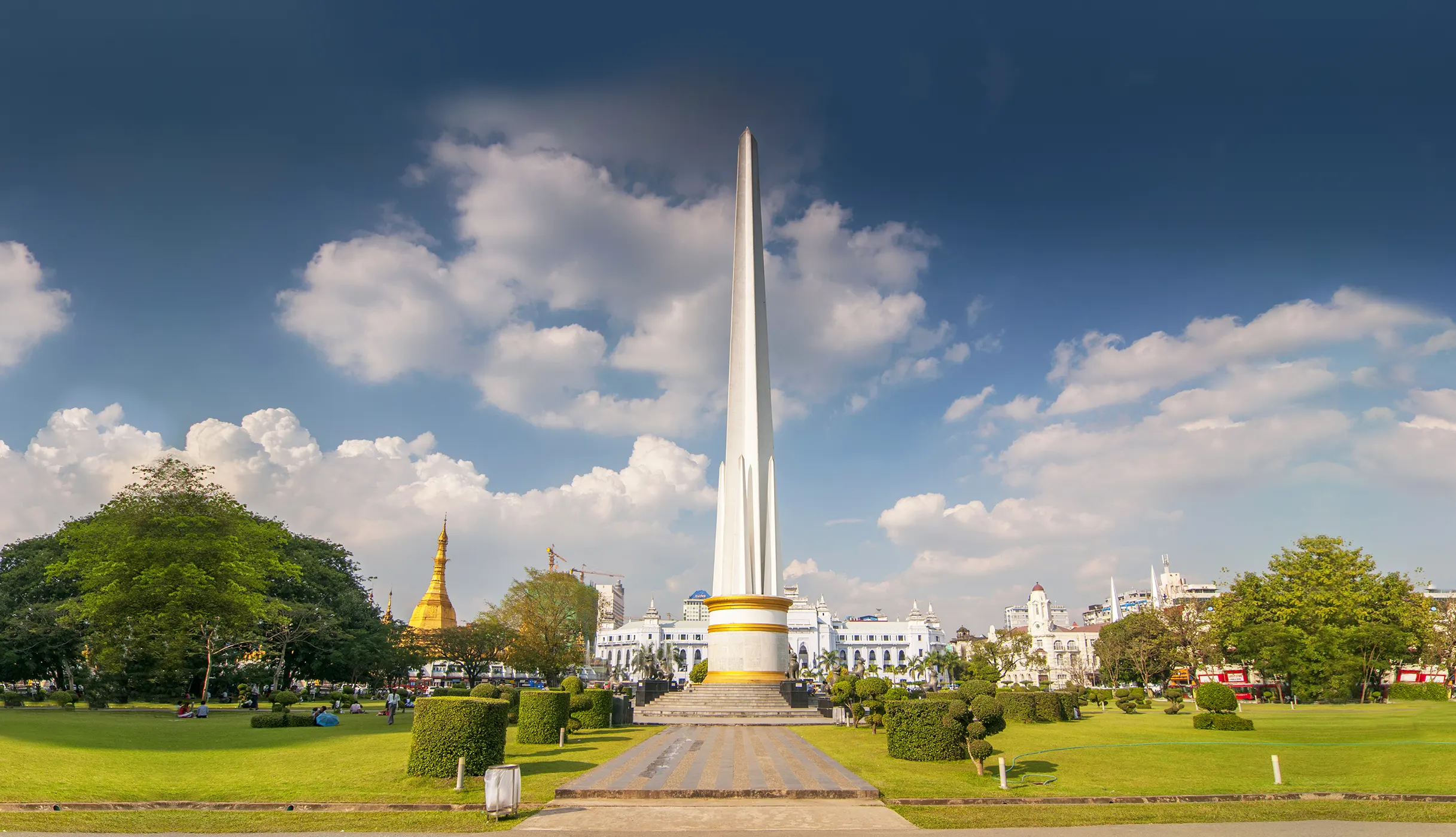
Independence Monument with City Hall & Sule Pagoda
Among others, attractions during this exploration will include the beautiful Saint Mary’s Cathedral with its exquisite collection of stained-glass windows, Sule Pagoda, Yangon’s City Hall, and Myanmar’s Independence Monument.
From here you can either drive or choose a 20-minute walk on interesting streets to the Botataung Pagoda. Located on the Yangon waterfront, this pagoda is where many Yangon residents come to pray. You can break for an early lunch now (your hotel and the historic Strand Hotel with its restaurant are both very close by), or enjoy a late lunch after your next adventure.
Across the street from where you are is the Pansodan Jetty on the riverfront in Yangon. At the jetty you will board the Ferry to the rural Dala region, which lies across the river from Yangon. Up until a couple of years ago, this extremely interesting cruise took about 15 to 20 minutes to complete. Since the Japanese government donated 3 new cruisers to Myanmar, the journey is just a few minutes, yet it is a fascinating glimpse into the life of the homeward bound villagers who belong to your destination, the rural Dala region. Vociferous hawkers walk among the seated passengers marketing all sorts of products, from food and household items, to clothing and toys for children.
Disembark from the ferry and proceed on an extended walk through this farming region that is dotted with small villages and local markets. Those that do not feel up to the walk can ask their Tour Director to arrange one of the unique trishaws that are found all over Myanmar. Although just across the river from Yangon, this is a different world, and the locals do not enjoy the big city sophistication and relative prosperity of Yangon’s residents. You will walk on dirt trails that are surrounded by farmland, farming and fishing villages with small rustic lodging, and little markets where the locals haggle over their daily needs. Photo opportunities of genuine native moments abound during this afternoon’s expedition as this area in mostly untouched by tourism. Return to the ferry and enjoy the noisy and colorful cruise back to Yangon. If you are so inclined, you can return to your beautiful hotel to freshen up and take a short break after the rural adventure.
After this you will be driven to the massive Chaukhtatgyi Reclining Buddha. This impressive image is also an attraction for locals and Buddhist monks who come here to pray. Of particular interest are the voluminous inscriptions on the soles of the feet of the statue.
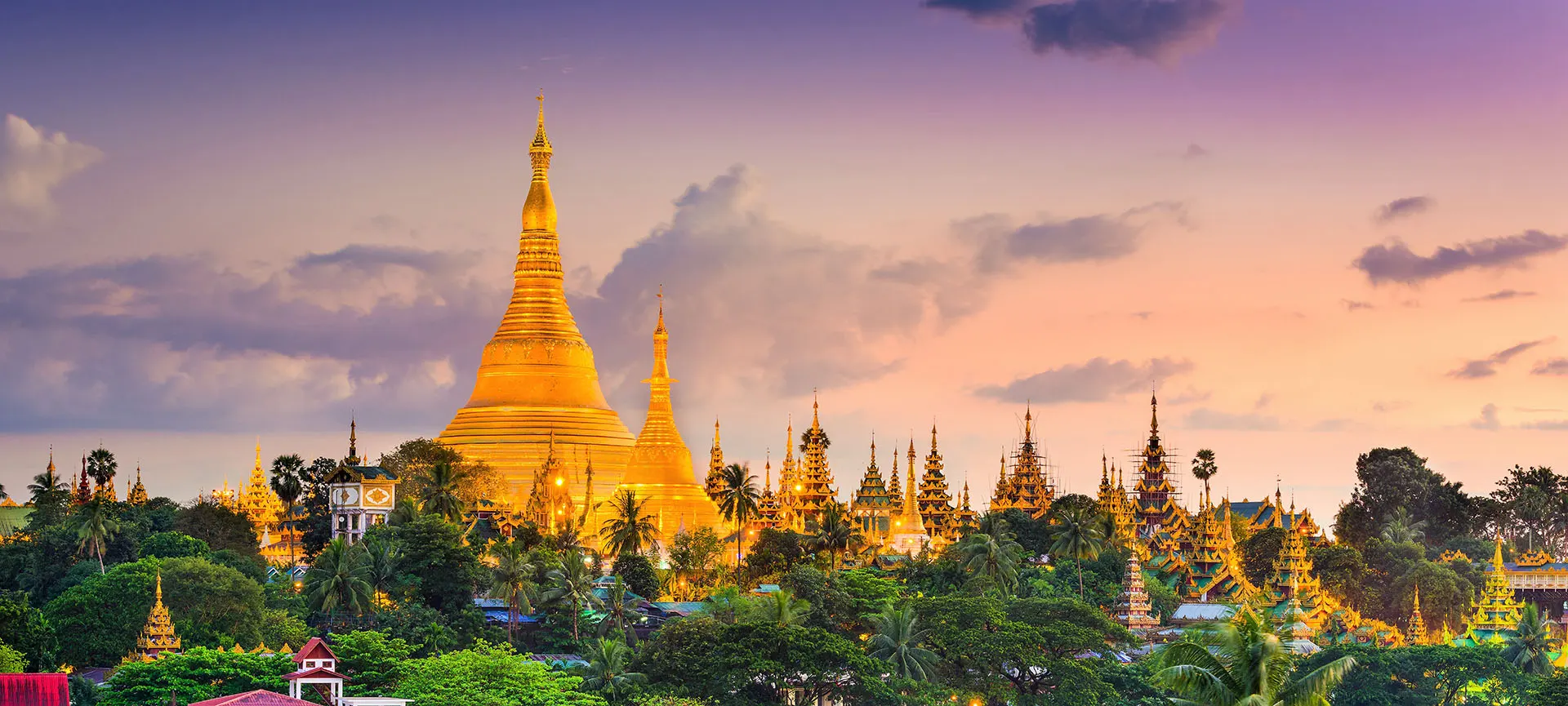
Shwedagon Stupa Complex
From here you will proceed nearby to the iconic Shwedagon Pagoda and its massive golden Stupa. This is Myanmar’s most treasured monument and you can easily spend hours exploring the various structures.
Legend has it that the Pagoda is about 2600 years old, which would make it the oldest Buddhist Stupa in the world. Academics do not agree, and date the original construction to somewhere between 600 and 1000 AD. Legend also states that the Stupa contains relics of Lord Gautam Buddha, and the three Buddha’s who preceded him. Although initially a much smaller structure, the structure was added to by various rulers over many centuries, and it now reaches a height of 325 feet, or 99 meters. Multiple lesser temples and other structures surround the Stupa in its hilltop location, dominating the skyline of historical Yangon. Many ceremonies will be taking place in the various structures of the complex and you will get a chance to observe them. There are hundreds of pilgrims and monks at the monument at any given time. You may also get to observe a class where young Buddhists are taught prayer techniques and/or other aspects of Buddhism.
Dinner at SEEDS Restaurant & Lounge
The SEEDS Restaurant & Lounge is located at the banks of magical Inya Lake. In this restaurant Mr. Eppisser has been guided by his wife Lucia Eppisser. The following description is provided by the restaurant: Stunning lake views from within the privacy of this romantic, light-filled restaurant offers guests the space to breathe, unwind and delight in an extraordinary culinary experience. SEED’s Special Dinner includes:
Guests are welcomed with one glass of Sparkling Wine and some canapés
You will have a festive table decorated with flowers in the pavilion or balcony
The whole table is surrounded by candles and a lot of candles are on the table
Dinner will be a festive 4-Course-Menu according to season, European and Asian inspired dishes, and there are 2 options for the main course. These include Amuse Bouchée and Friandises. After dessert a farewell-cake will be served.
Day 3: Yangon – Bagan. (Breakfast) You are assisted with your check-out in the early morning and driven to the airport to board the morning flight to Bagan. Upon your arrival at Bagan you are driven to Nyaung Oo market. This bustling market is always full of local shoppers buying a variety of beans, sesame, vegetables, flowers, bamboo wares, various kinds of Thanakar (the tree bark derived paste that almost all rural Burmese women apply to their family’s faces), and many other consumables local to this region. You will see Buddhist nuns as they visit the stalls and ask for supplies for their afternoon meal.
From the market you will be driven to the archaeological zone and introduced to one of the area’s foremost experts. Mr. U Myo Nyunt Aung; an independent Research Scholar as well as former Deputy Director of the Department of Archaeology.
He is also an Executive Member of the Association for the Protection and Preservation of Bagan Cultural Heritage Region. His in-depth knowledge will give you the opportunity to discuss the local history, architecture and preservation efforts, above and beyond what your very knowledgeable Tour Director will provide.
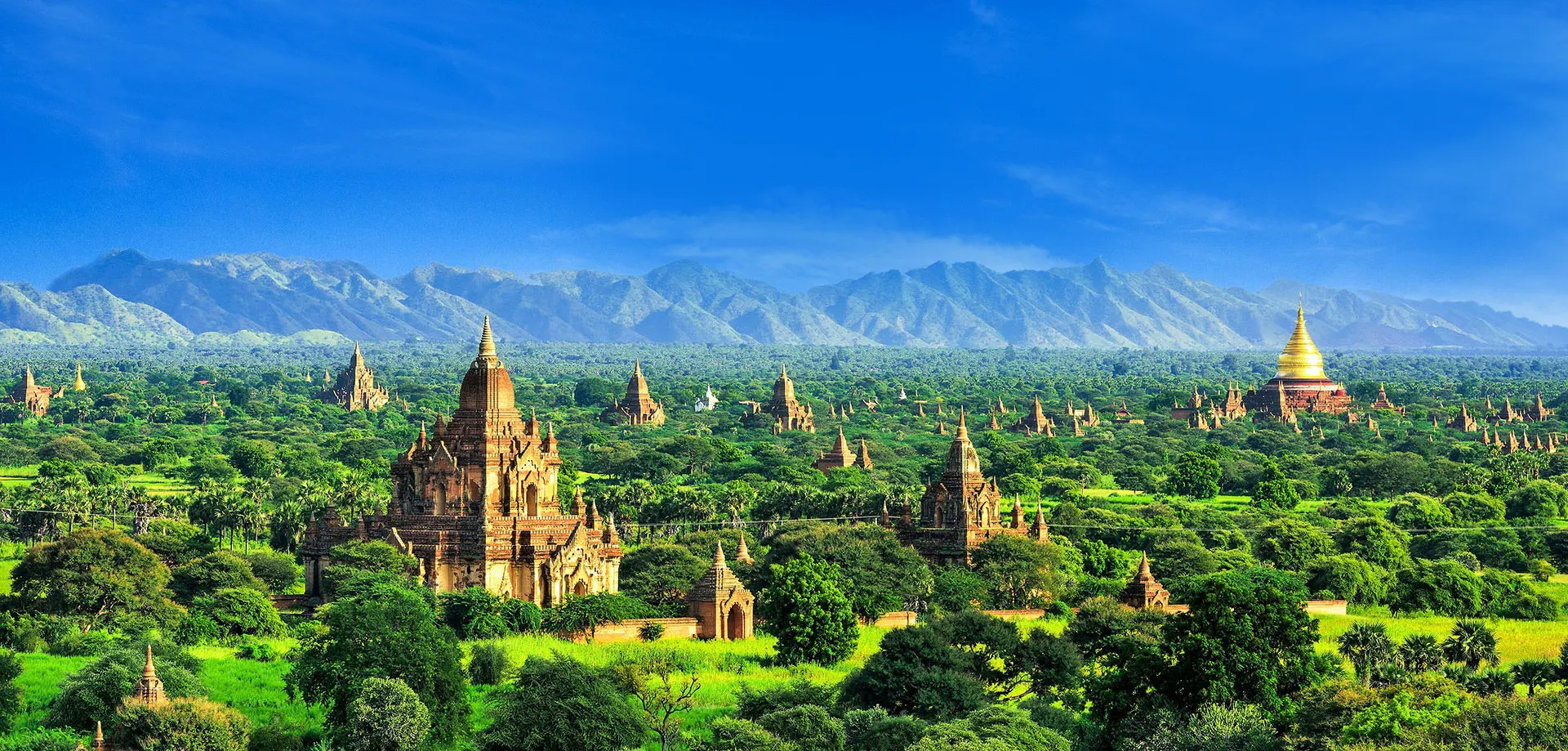
Bagan Landscape
The landscape at Bagan is spectacularly otherworldly, with over 3800 pagodas and temples spread over miles of lush green countryside and jungle. Some are massive and have well preserved and exquisite details; others are smaller and in various stages of disrepair.
Due to tourism related damage to the priceless structures, a few years ago the authorities ruled that no one is allowed to climb Bagan’s monuments. Start with the thousand-year-old Shwezigon Pagoda, a great example of prototypical Burmese architecture. It was built of sandstone carried from the quarry at Turintaung Mountain (seven miles away from Shwezigon) by using a chain of people. As mentioned earlier, the massive Archaeological Zone at Bagan is other-worldly and amazing photo opportunities are everywhere you turn. Adding to this charm is the fact that cowherds and goatherds can sometimes be seen grazing their livestock around these monuments, seemingly oblivious to their magical surroundings.
Next you will visit the Wetgyi-in Gubyaukgyi Temple, which was built about 900 years ago. The temple has a large collection of well-preserved wall paintings that depict scenes from the 550 jatak life stories of the Buddha. After this you will drive a short distance and visit the beautiful Ananda Temple, one of the most impressive and exquisite monuments of Bagan. It was built in 1091 A.D. and it stands out among the hundreds of ancient structures around it. The last of this morning’s experiences is the awe-inspiring Dhamayangyi Temple, the largest temple in Bagan. The craftsmanship of this temple is widely regarded as one of the best examples of precision brick work during the Bagan Era. The design of the temple is, in some ways, similar to the Ananda Temple, but on a much larger scale. Most of the interior has been walled off by the authorities.
After this temple there is a break for lunch, which can be enjoyed at a restaurant on the banks of the scenic Irrawaddy River, or at your resort. After lunch you are assisted with your check-in to your boutique resort, Bagan’s best upscale lodging, and then you are at leisure for a little while to freshen up after your early start and busy morning.
Mid-afternoon - enjoy an excursion to the striking Thabyinnyu Temple, one of the oldest structures in Bagan, and the tallest temple (217 feet, 66 meters) in the region. The temple’s size and unique white façade make it stand out from all the other monuments at Bagan. It is featured in many photos of Bagan’s landscapes.
Next you will board your horse cart and enjoy a short ride (you can also choose to be driven in your vehicle) to the iconic Shwesandaw Pagoda, the tallest (328 feet, 100 meters) pagoda in Bagan. The massive stupa has a succession of five terraces, culminating with a conical stupa. The thousand-year-old monument is purported to house some of Lord Buddha’s hair.
Day 4: Bagan – Mandalay. (Breakfast) An optional Balloon Ride over Bagan is available early this morning.
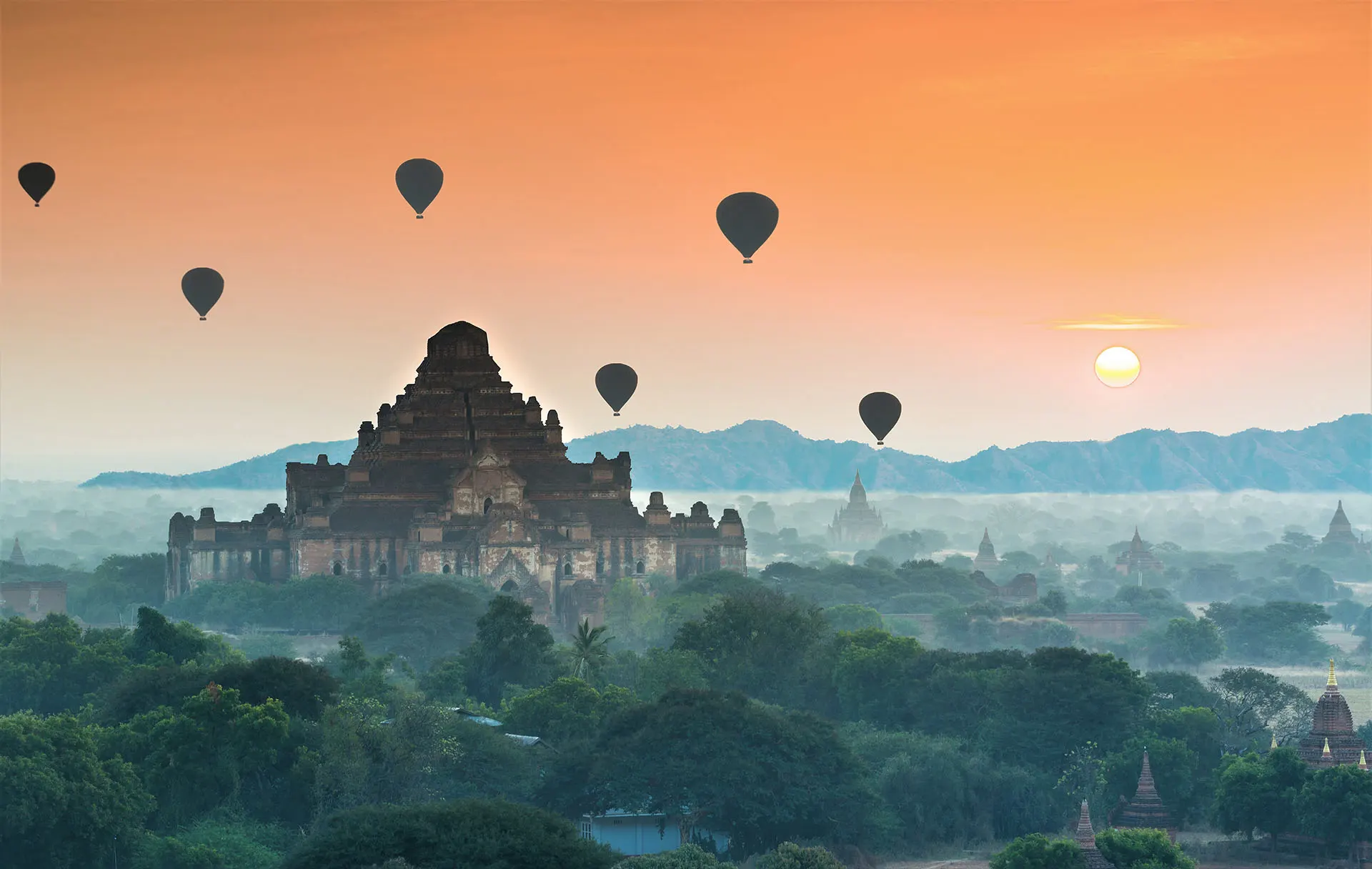
Balloons Over Bagan at Sunrise
This sunrise ride offers a dreamlike panorama of the magnificent green valley and its incredible plethora of monuments.
We use Myanmar’s best Balloon operator and this selection has to be made during your reservation process, with a surcharge of $304 per person. After breakfast, you are assisted with your check-out and then you proceed to Bagan’s oldest lacquerware workshop, where you can try your hand at one of Burma’s traditional art forms. You’ll be shown around the workshop where every phase of production, from splitting the bamboo to etching designs, are performed. - Each stage will be described in detail to give you an understanding of how this ancient craft has developed into an art form.
After this you will head out towards Mandalay, with a diversion for an excursion to Mt. Popa (4981 feet). This extinct volcano offers amazing views of the Bagan valley and the river. Lunch at the Popa Mountain Resort, while enjoying the stunning view, is strongly recommended. You can opt for the strenuous climb up to Popa Temple by the old iron stairway for even better views of the Bagan plain, but please note that this will make your arrival in Mandalay fairly late. The four-hour (approximately) drive to Mandalay is through scenic rural countryside, and lots of opportunities to view, and photograph, farming communities as they go about their daily lives. Upon your arrival you are assisted with your check-in to your suite at Mandalay’s newest, and best, upscale hotel.
Day 5: Mandalay. (Breakfast) Join Your Tour Director this morning and head to Amarapura, the 18th Century capital of Myanmar. You will now visit Myanmar’s largest monastery, Maha Gandayon. A walking tour of the monastery where well over a thousand young apprentice monks (ranging from about 6 years to early manhood) spend many years under the tutelage of senior monks will give you insights into how the young monks live in dormitories, and how their day is spent in education and prayer. You will have the opportunity to observe a fascinating ritual, the process of how thousands of daily meals are prepared to feed the monks, from their supply stores to their massive cauldrons in which the food is cooked. After this you will briefly watch and photograph as over a thousand young Buddhist monks line up, and very slowly move to the front of the line so that they can be served, and then consume their main meal of the day. Due to the crowds of camera and phone deploying tourists nowadays, and out of respect for this ritual, Easy Tours does not have our guests spend much time observing this procession of about a thousand young monks.
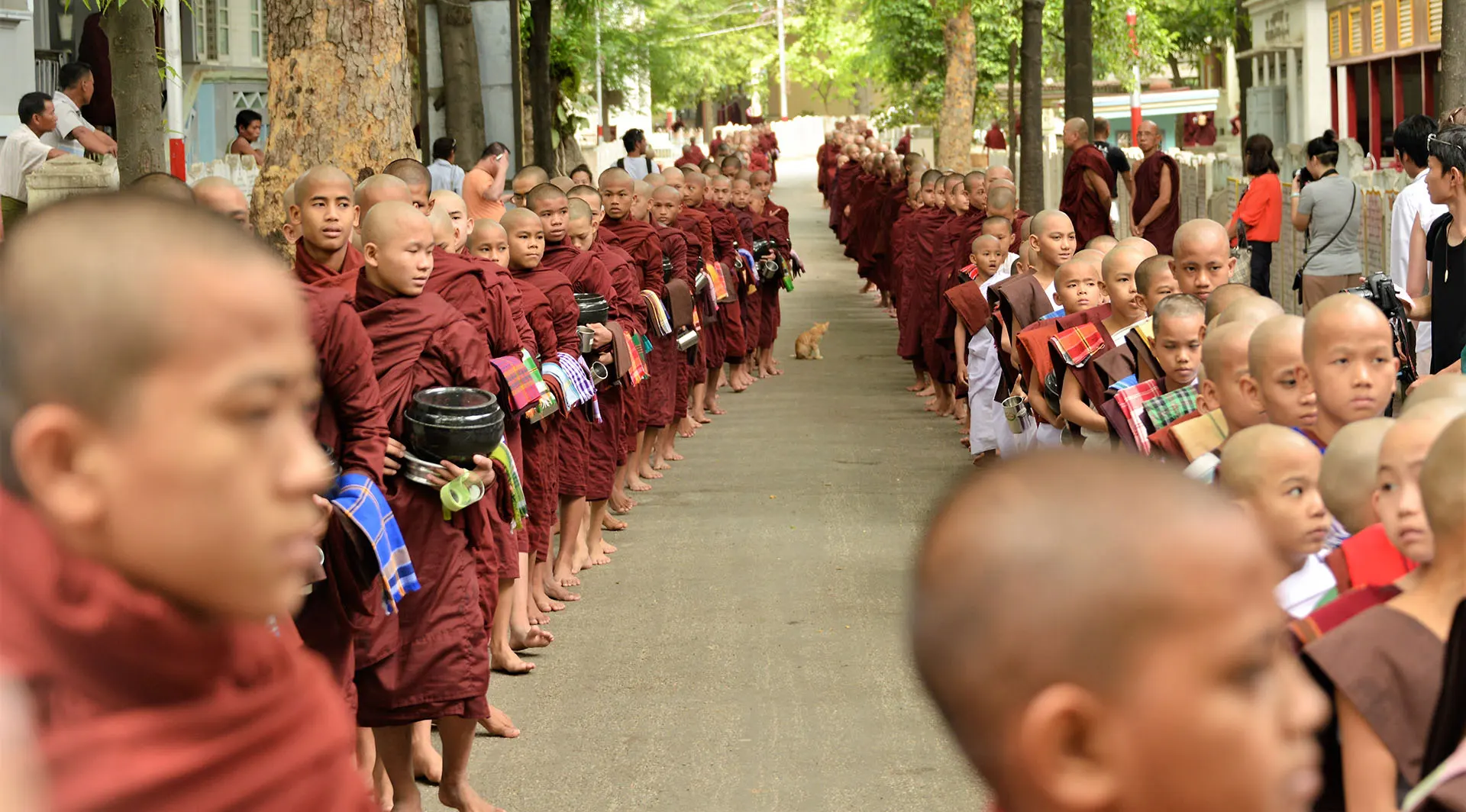
Amarpura Mandalay Lunch Line
The lunch line ritual takes about an hour before the last of the young men gets seated. Myanmar’s affluent families provide these meals and there is a waiting line of months, sometimes stretching into years, for this privilege.
While the line of young monks slowly moves up, you will move towards a different vantage point that allows you to view parts of the dining halls. Burmese families consider a monk in the family as the highest honor. You will start exploring the massive dining halls at a covered outdoor hall which will be occupied by a group of very young boys dressed in white robes. They are not part of the monastery, and are brought here by their families to get acquainted with life in the monastery.
At Amarapura you also have the option, if you so desire, to observe the local specialty, traditional silk weaving. The craftsmen meticulously design and manually create the silk garments that are worn by Burmese for special occasions like wedding ceremonies, graduation or major cultural and social events.
After a break for lunch you will cross over the historic AVA Bridge (built in 1927 by the British Occupiers, then partly damaged during WWII, before being renovated in 1954) to Saggaing. Saggaing Hill offers a panoramic view of the Irrawaddy River and the hills on the other side. After admiring the view, you are driven to the bottom of the hill and you will now visit one of Myanmar’s unique nunneries. According to local belief, the direct lineage of the women monks in Myanmar’s prevalent form of Buddhism, Theravada Buddhism, died out in ancient times. The governing council of Buddhism in Myanmar has ruled that there can be no valid ordination of women in modern times, and Buddhist nuns are not held in anywhere close to the reverence that male monks are; actually, it is quite the opposite. At the nunnery you will learn about the unique lifestyle of Burmese nuns and their beliefs, while you observe some of their daily activities.
After this you will head back toward Mandalay, and your last stop today is a very unique bridge that offers amazing photo opportunities. The 160-year-old U Bein Bridge is the longest teak bridge in the world. Enjoy a walk along part or all of the 1.2-kilometer-long bridge. Please note that the bridge is always full of locals and tourists, and so, rather than walking the whole bridge, we recommend a partial walk, and then the following sampan ride. You have the option to board a Sampan, which is a small wooden rowboat, so that you can cruise along Taung Tha Man Lake and admire the bridge from a short distance, especially as the sun sets over the horizon.
Day 6: Mandalay. (Breakfast) Start your day with a drive through the rural countryside. You will arrive at a jetty from where you will board a private boat to cross the mighty Irrawaddy. The cruise takes about an hour and you will go by tiny fishing hamlets on islands in the river. If you are fortunate, you may get to see river dolphins on this cruise, although they don’t often venture this far south on the river.
As you approach the banks on the other side of the river, you will be greeted by the sight of the massive unfinished pagoda that awaits you at Mingun village.
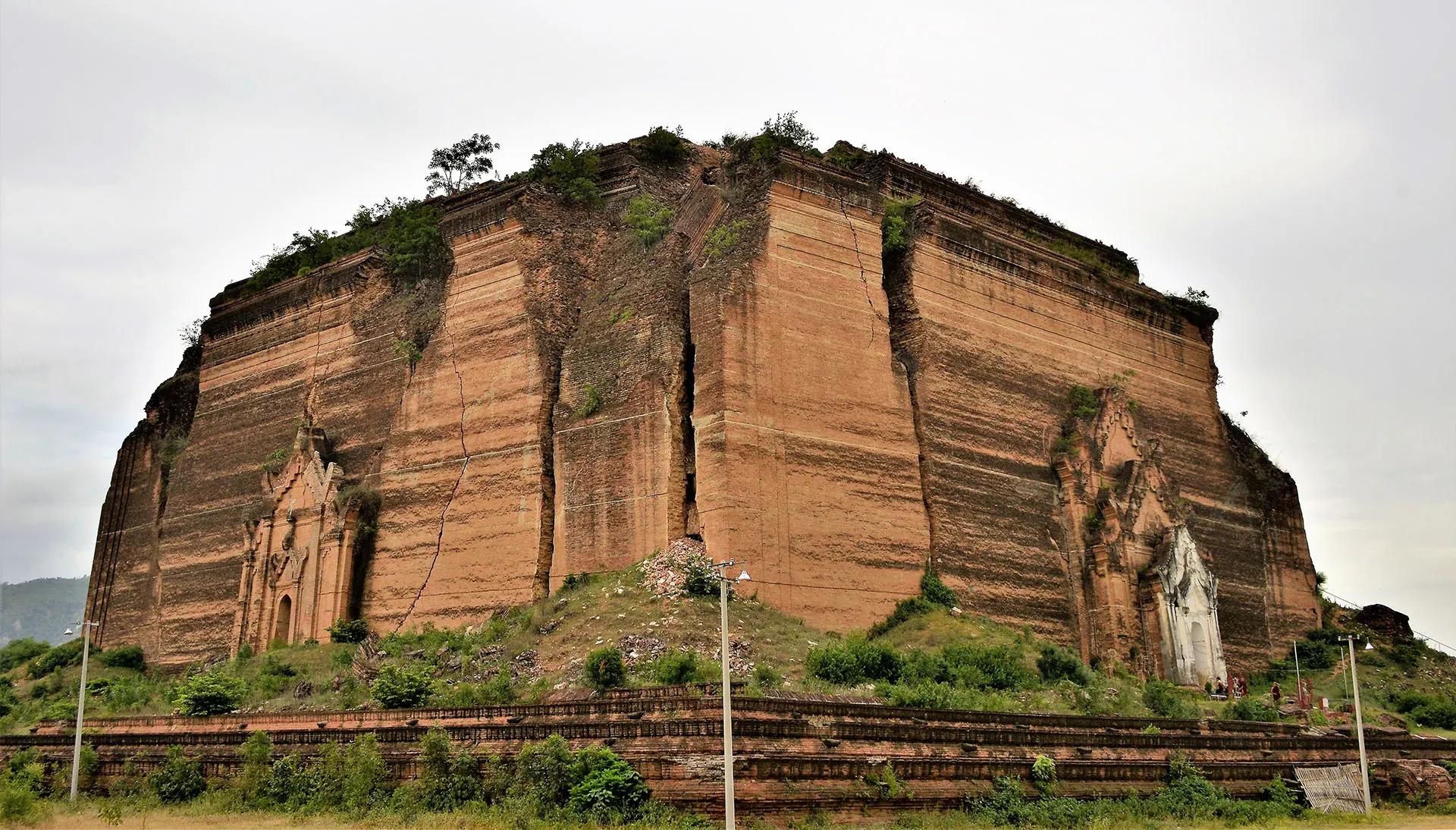
Pa Hto Daw Gyi Pagoda Mandalay
Pa Hto Daw Gyi Pagoda was started in 1790 but, due to the king’s death, construction stopped after about 20 years.
20,000 laborers were employed in its construction,and the depletion of the kingdoms reserves on its construction costs is rumored to have been behind foul play that was suspected in the king’s untimely death. The massive unfinished brick structure has major cracks that were caused by an earthquake in 1838.
The next stop on your adventure is the enormous Mingun Bell which was constructed by the same king around 1810. At 90 tons (200,000 lbs.), it is said to be the largest ringing bell in the world. After ringing the bell, which is done by hitting the sound bow with wood, you will enjoy a short village walk through the ancient fishing village and observe the lifestyles of the locals. Your last brief stop at Mingun will be at the strikingly white Mya Thein Dan Zedi Pagoda, built by the King of Saggaing as a memorial for his beloved wife, who passed away one week after giving birth to their son. This charming white structure is quite different from any other pagoda you will see in Myanmar, and the local’s call it Myanmar’s Taj Mahal. Return to the jetty for your scenic cruise back to Mandalay. Disembark at the jetty and there is a break for a late lunch.
After lunch you will enjoy a guided visit to the Maha Muni Image. This is the most sacred Pagoda in Upper Myanmar and a treasure trove of Buddhist culture.
The main Buddha statue at the temple continuously increases in size as devout Buddhist men place gold leaf on it throughout the day, as an offering to Lord Buddha. Next is the Shwenandaw Monastery, a masterpiece of wood carvings, constructed with teakwood from the palace of the last Burmese King. The incredible detail of the teak carvings is a must for visitors to Mandalay. Rulers of this kingdom had a tradition of not wasting the teak of structures that became obsolete, so they were disassembled and used for other construction.
The next experience will be the Kuthodaw Pagoda with its 729 stone slabs (housed in separate structures) of Buddha’s scriptures. This impressive complex is known as the world's biggest book. As you walk through this interesting complex, and peek at the meticulously carved slabs, you will be reminded of the simple spirituality of the Burmese people. Your last stop today is at the top of nearby Mandalay Hill, from where you will enjoy magnificent sunset views of the Mandalay region and the mighty Irrawaddy.
Day 7: Mandalay – Heho – Inle Lake. (Breakfast) You are assisted with your check out from your hotel in the early morning and driven to the airport to board the short flight to Heho. Upon arrival at Heho Airport, you are greeted by your chauffeur and then you start on the scenic 90-minute drive during which you descend from the mountains to the amazing Inle Lake region. Upon your arrival at Nyaung Shwe Village, the main access point to Inle Lake, you are assisted to the jetty where you will board a boat for your journey to the heart of the lake.
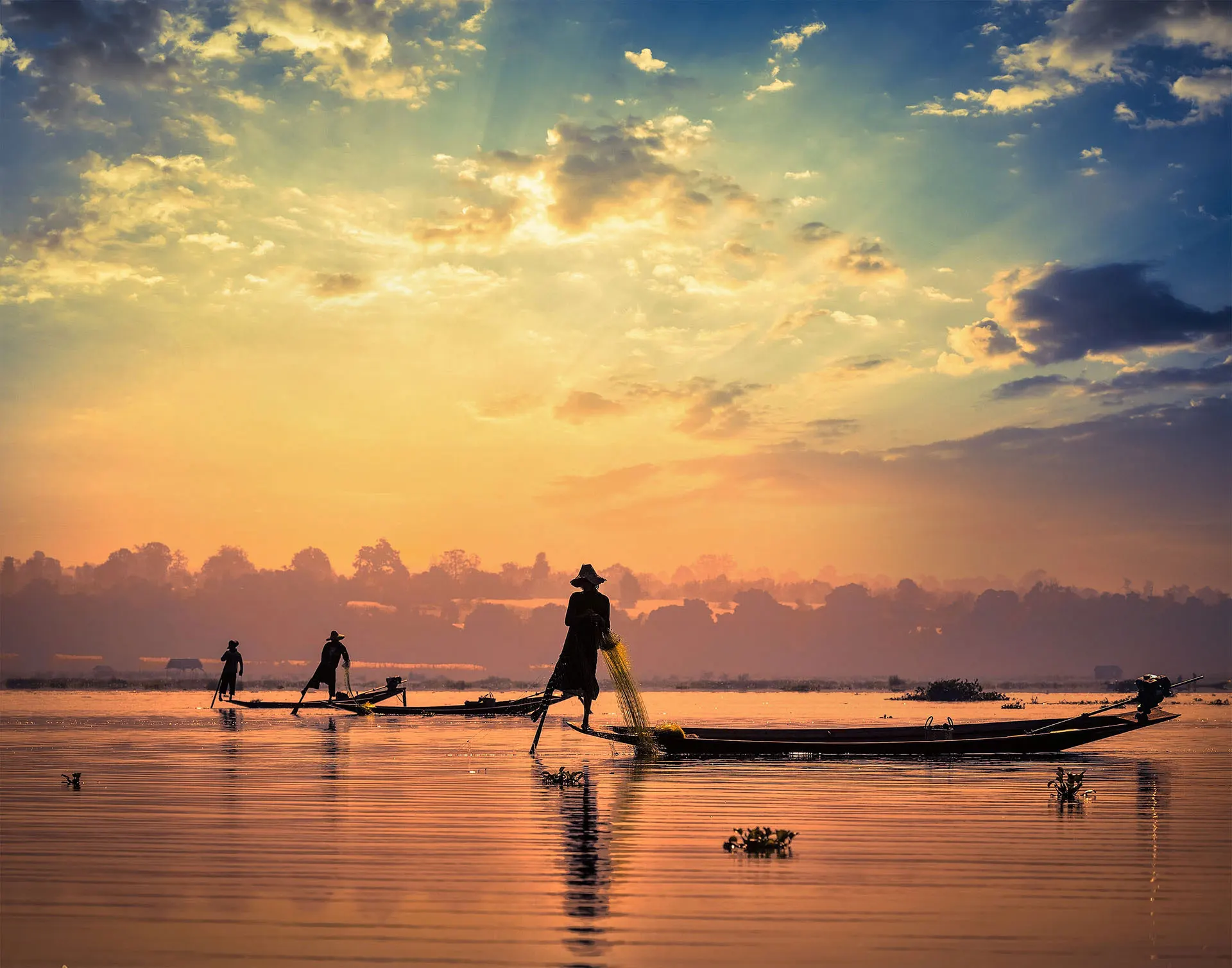
Fishermen on Inle Lake
This journey will serve as your introduction to life in this aquatic region as you go past scores of boats that the locals use to transport their agricultural produce.
Inle Lake is almost 14 miles long and over 10 miles wide, with an average depth of 20 feet. There are 64 villages, whose inhabitants reside on the lake in their homes that sit on stilts above the water. The incredible floating cultivation process that takes place on the lake has to be seen to be believed. Millions of pounds of vegetables (with tomatoes being king) are grown here every year and shipped all over Myanmar. Everywhere you turn there is amazing scenery and examples of the unique local lifestyle.
During your explorations at Inle you will frequently be cruising through many fascinating floating villages. There are over 100 monasteries on the lake, and you can opt to start your exploration of Inle Lake with a visit to Nga Hpe Kyaung, the Jumping Cat Monastery. This is a unique (for this region) teak monastery with tall beams supporting the roof and teak Buddha statues.
After exploring the monastery there is a break for lunch at one of the boutique restaurants that offer great views of the lake, or you can have your boat take you to your luxury lakefront resort, again the best upscale lodging in Inle, and have lunch before you are assisted with your check-in. Your suite has a large terrace overlooking the lake. After freshening up you can either enjoy the facilities and views of your resort or continue exploring the lake and the local culture with your Tour Director.
Day 8: Inle Lake. (Breakfast and Lunch) If a floating market is scheduled in your resort’s vicinity this morning, you have the option to visit it. Not including the possibility of the market, your first adventure today is the Indein village, which is both a fascinating journey and a rewarding destination. After cruising through much of the lake and many photo opportunities of fishermen and lake life, you will enter a picturesque canal at the edge and navigate your way to this ancient village. Hundreds of pagodas, many of which are crumbling, are clustered in the picturesque complex. These ancient structures are said to have been built by one of the kings from the Bagan era. You will also enjoy a walk through the bamboo forest, then a gentle climb up the stairways to the hill, which offers a magnificent view over the lake.
An exotic Lunch is served on a converted rice carrier boat in the middle of Inle Lake. The boat has been transformed for formal dining, and each course of fresh gourmet local cuisine is manually rowed by charming local ladies to your servers from the kitchen boat a short distance away. Enjoy the amazing scenery as well as your food and wine.
After lunch you will visit Phaung Daw Oo Paya, which is the Inle regions most auspicious Buddhist site. Housed in this beautiful temple complex are five small gold 800-year-old Buddha statues and a steady stream of worshippers graces the sanctum. The locals have been applying gold leaf to these statues for centuries and the figures are no longer identifiable as the Buddha as we usually see him. Later in the afternoon you will enjoy a visit to Inpawkhon village where you can observe a traditional weaving Mill.
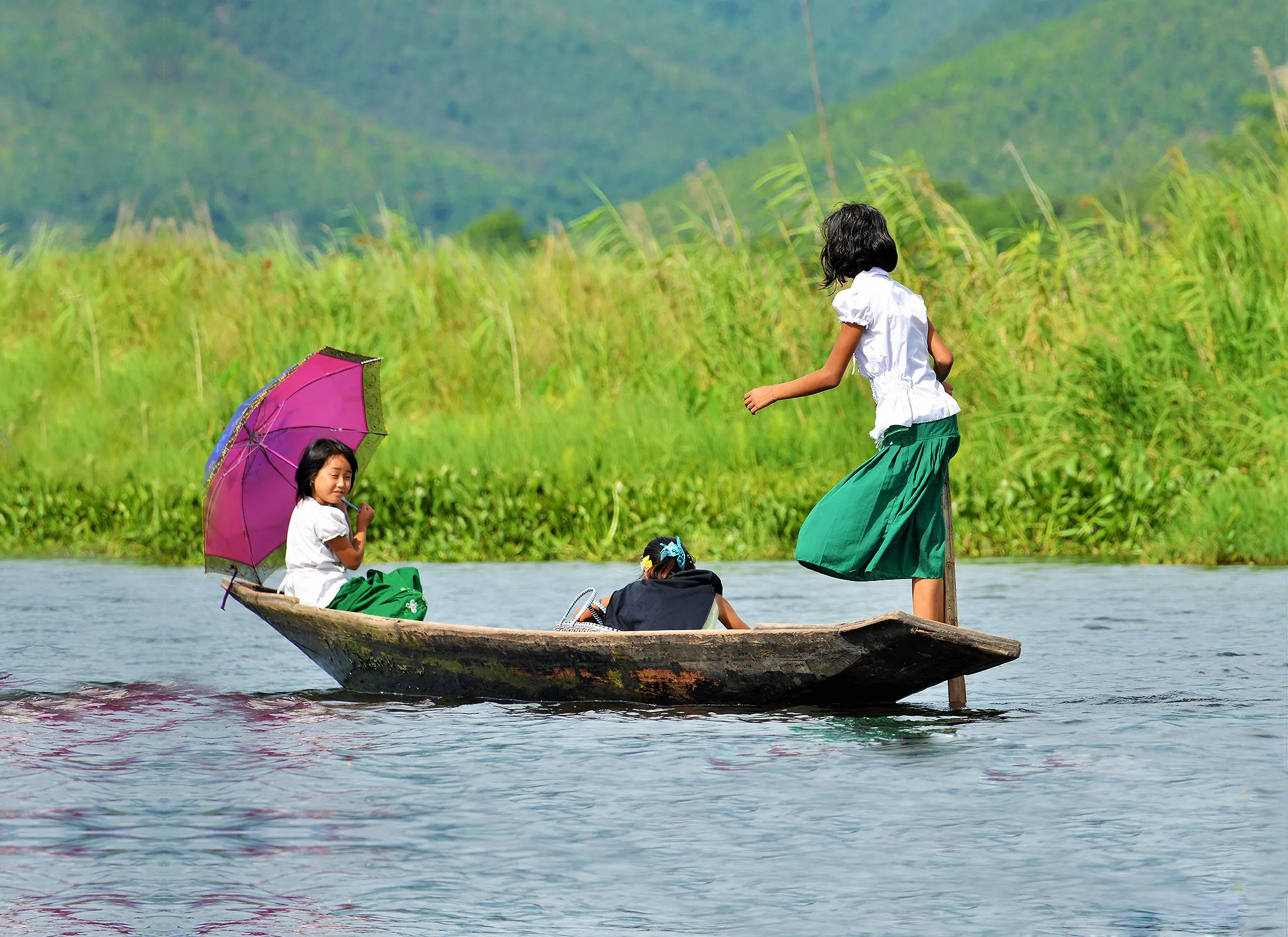
Returning from School on Inle Lake
After that you will cruise through nearby Nam Pan Village and get a close up look of people who seldom touch dry land. It is not unusual to see a 5 or 6 year old rowing their own boat around the village; the children here learn how to row soon after taking their first steps.
This afternoon’s stops will include, if you like, a visit to a facility where they make Shan paper, which is made of mulberry bark and transformed into Shan umbrellas and other beautiful local products. At the end of the afternoon you will return to your resort.
Day 9: Inle Lake – Yangon – International Flight. (Breakfast) You are assisted with your check-out in the early morning and your boat will now take you back to the jetty at Nyuang Shwe, where you will disembark and proceed on the scenic mountain drive back to Heho airport to board your flight to Yangon. Arrive in Yangon and depending on the departure timing of your international flight, you may choose to explore more of Yangon this afternoon, breaking for lunch at a time of your choice before returning to the airport to board your international flight. Bid farewell to your Myanmar Tour Director at the airport, where you will be introduced to your VIP Airport Concierge and then be escorted through all departure processes.
Please note that international flights have check-in requirements that require you to be at their check-in counter approximately 2.5 to 3 hours (for coach), and 2 hours for premier classes, before that flight departs. Please also allow for unexpected delays on the flight from Heho to Yangon. If you used Easy Tours advice/assistance for your international flights, we would factor in the above.
Our services will end at the airport.
Lodging
| Yangon |
The Rosewood Yangon – Grand Heritage Room with River View Terrace
|
| Bagan |
Aureum Palace Bagan Hotel – Jasmine Orchid Lake View Villa
|
| Mandalay |
Pullman Mandalay Mingalar Hotel – Deluxe Suite (Club Benefits*)
|
| Inle Lake |
Sofitel Inle Lake Myat Min – Opera Lake View Suite with Terrace
|
Inclusions
| VIP Airport Concierge on all International Arrivals and Departures (2 Services) | |
| Accompanying Tour Director for Airport Assistance on all in-country flights | |
| Breakfast daily | |
| Fine Dining Experience at SEEDS Restaurant in Yangon | |
| Private Floating Lunch Boat with Gourmet Cuisine on Inle Lake | |
| Ground transportation via upscale private vehicles | |
| Services of the best English-speaking Accompanying Tour Directors | |
| Applicable monument entrance fees as per the itinerary | |
| Bottled water during sightseeing | |
| Hotel accommodation as listed above | |
| All Boat Fees/Fares per the itinerary |
Not Included
| International travel except countries on your Easy Tours Journey | |
| Any expenses of a personal nature, such as tips, laundry, phone calls, drinks etc. | |
| Meals other than those specified on itinerary | |
| Travel insurance, visas, etc. |

